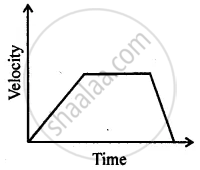Advertisements
Advertisements
प्रश्न
How will the equations of motion for an object moving with a uniform velocity change?
उत्तर
For an object moving with a uniform velocity, acceleration a = 0.
∴ Equation of motions v = u + at, s = `"ut" + 1/2 "at"^2`
and v2 − u2 = 2as change to v = u, s = ut and v = u
APPEARS IN
संबंधित प्रश्न
Derive the formula s= `ut+1/2at^2` , where the symbols have usual meanings.
A train starting from stationary position and moving with uniform acceleration attains a speed of 36 km per hour in 10 minutes. Find its acceleration.
A car acquire a velocity of 72 km per hour in 10 second starting from rest. Find
(1) the acceleration,
(2) the average velocity, and
(3) the distance travelled in this time.
A car is travelling along the road at 8 ms-1. It accelerates at 1 ms-2 for a distance of 18 m. How fast is it then travelling ?
When a car driver travelling at a speed of 10 m/s applies brakes and brings the car to rest in 20 s, then retardation will be :
What do you understand by the term acceleration?
Can you suggest a real-life example about the motion of a body from the following velocity – time graph?

A packet is dropped from a stationary helicopter, hovering at a height ‘h’ from ground level, reaches the ground in 12s. Calculate
- the value of h
- final velocity of packet on reaching the ground. (Take g = 9.8 ms−2)
An electron moving with a velocity of 5 × 104 ms−1 enters into a uniform electric field and acquires a uniform acceleration of 104 ms–2 in the direction of its initial motion.
(i) Calculate the time in which the electron would acquire a velocity double of its initial velocity.
(ii) How much distance the electron would cover at this time?
When will you say a body is at uniform acceleration?
